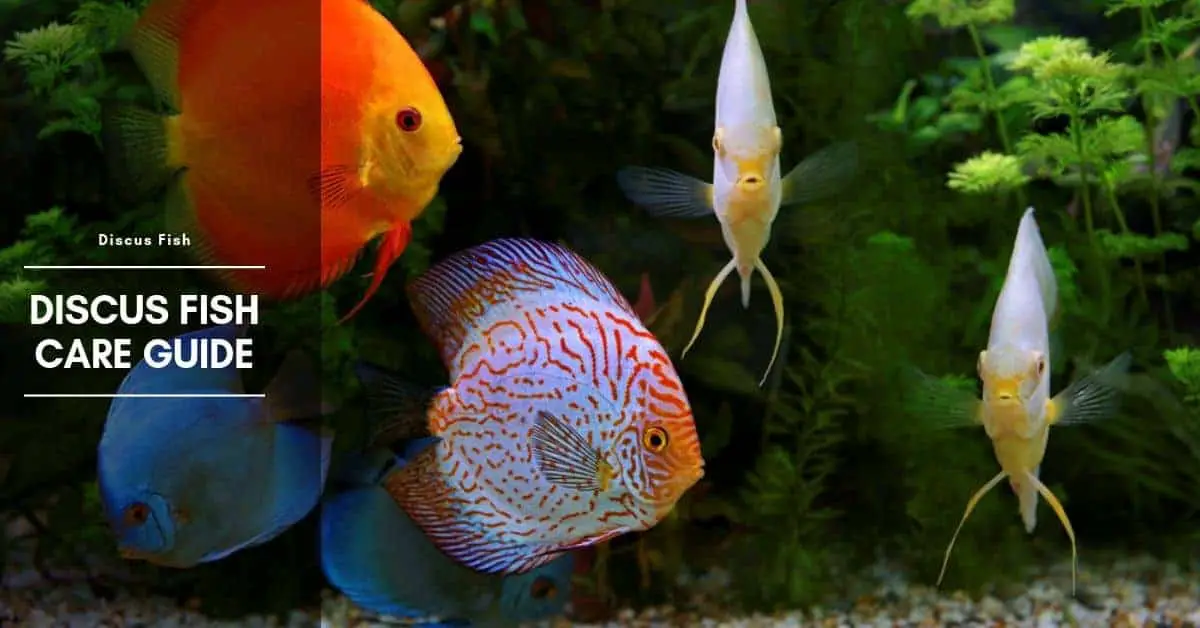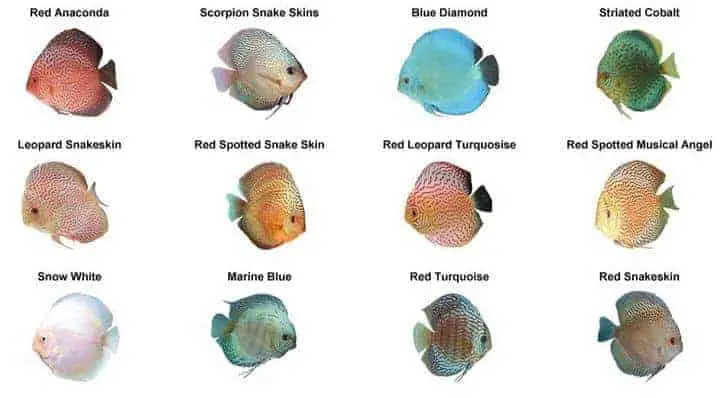Discus fish require a lot of needs and demands to be happy; it could be a great challenge keeping types of discus fish if you are not prepared for the task. You may have heard many people tell the story of how they failed; you do not have to worry, with this post, you would be equipped with discus fish care that will guarantee your success.
Read this guide to the end to have the right knowledge and tools required, and experience the fun and reward that discus fish breeding offers.
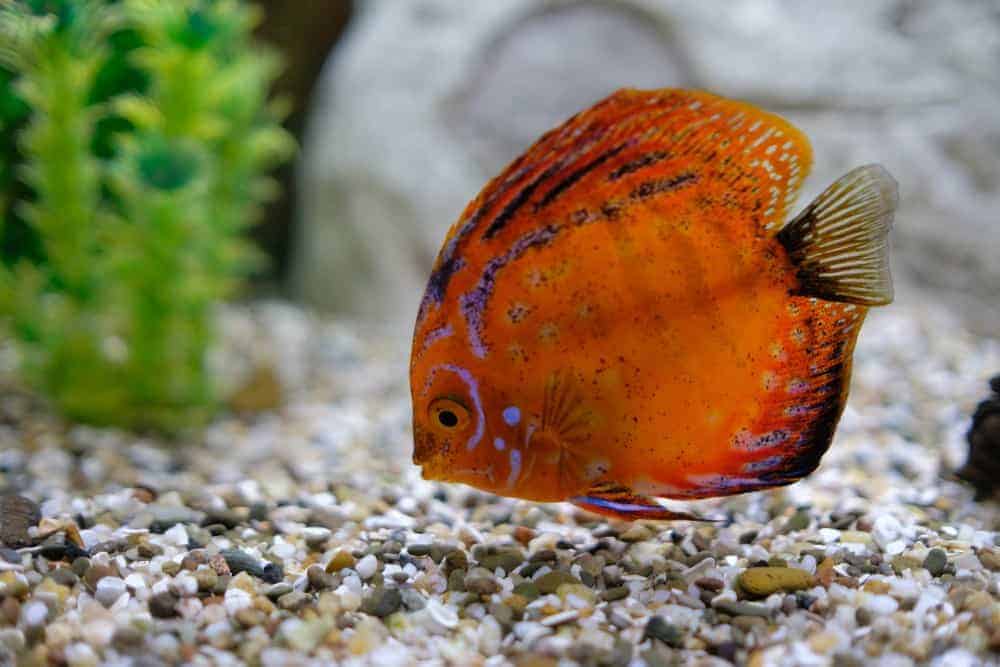
Discus Fish Types
It is only in one area of the world that discus fish are found – the Amazon River. Discus fish types are classified into natural species and human-made species. The natural species include the Heckel discus, brown discus, blue discus, and green discus while the human-made species comprise the leopard snakeskin discus, red turquoise discus, blue diamond discus, peach white, super red melon, and golden discus.
Red Tropical Symphysodon Discus
The Heckel Discus, or Symphysodon discus, is native to the central/eastern region of the Amazon, originating from the Rio Negro in Brazil. This species is easily distinguished in that of the nine bars running vertically across the body, the first, fifth and ninth are bold in comparison to those exhibited by other species.
The first of these bold stripes runs vertically through the eye and the ninth through the caudal fin. The fifth and most prominent stripe runs vertically down the center of the body. This stripe is noticeably wider than the other stripes in mature adults of the species.
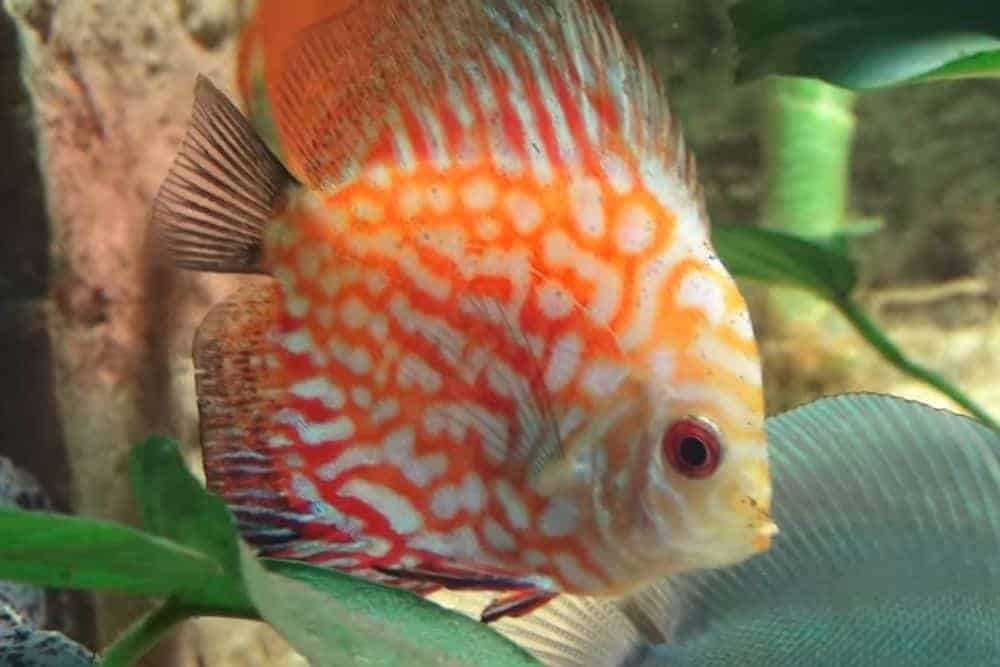
The Heckel Discus is also known as the Pompadour Fish and comes in two varieties – the Red Heckel Discus and the Pineapple Discus. The Red Heckel’s body is reddish-brown in color, marked with blue or turquoise veining and red coloration on the edges of the fins. This type of discus is widely considered to be among the most beautiful freshwater fishes. The Pineapple Discus, native to the Rio Abacaxis south of the Amazon, exhibits a faded, pastel coloration with a broad central band.
Both variants of Heckel Discus are relatively peaceful and shy, though they prefer to be kept in pairs or groups with other discus. These fish require a lightly planted aquarium with subdued lighting and soft substrate, an environment that mimics the calm waters of their native home in the Amazon.
The Heckel Discus is notoriously difficult to keep in the home aquarium because it is more delicate than other species – these fish have specific requirements for tank conditions and are particularly sensitive to water changes and susceptible to disease.
Brown Discus, Symphysodon Aequifasciatus Axelrodi
This group of discus can be divided into three sub-species based on coloration: brown, blue and green. The brown discus, Symphysodon aequifasciatus axelrodi, was once one of the most popular types of discus fish because it can be easier to keep compared to other discus variants in the home aquarium. This sub-species varies in coloration from light brown to a rust-like reddish brown. Like all discus, the brown discus has a series of vertical stripes running across its body and these stripes are most noticeable around the fins.
Symphysodon aequifasciatus haraldi, or the blue discus, generally exhibit a dark blue or purplish brown coloration on their bodies. The blue discus is easily recognized by the blue longitudinal stripes and dark banding that runs horizontally along the body. Some variants like the Cobalt Blue Discus have a metallic sheen while others, like the Royal Blue Discus, display a mixture of bold colors like blue and yellow.
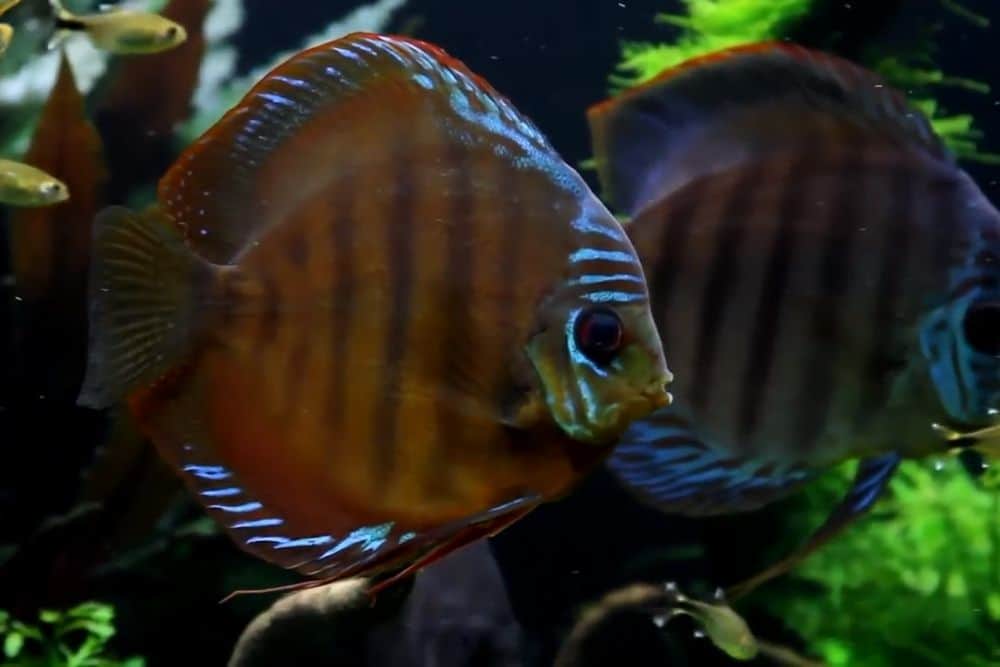
This sub-species of discus can be moderately challenging to keep in the home aquarium due to their nutritional needs and water quality requirements. Like all discus, Blue Discus are largely carnivorous and require a varied diet of live, frozen and pellet foods. In addition to their strict nutritional needs, Blue Discus require soft, acidic water similar to their native South American habitat.
The final sub-species of Common Discus is Symphysodon aequifasciatus aequifasciatus, or the green discus. This group of discus fishes displays a wide variety of colorations ranging from solid green to yellow-green to brown. Though they display a wide range of colors, the intensity of their coloration is often rather bland. In the home aquarium, these fish can be highly challenging to keep due to their specific requirements for water conditions.
Symphysodon tarzoo, Tefé Discus
This species of fish is not, in fact, a new species but rather one that has been a part of the aquarium trade for years under the name Tefé Discus. In recent years, however, these fish have been recognized as a species separate from the central/eastern species of discus Symphysodon aequifasciatus and Symphysodon discus.
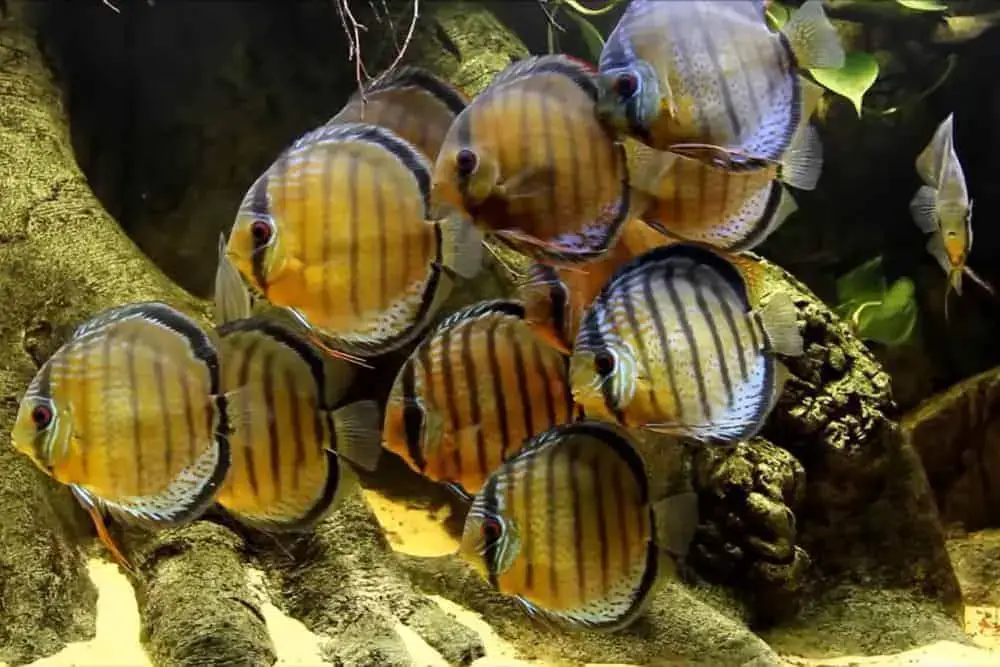
Symphysodon tarzoo was first studied during the 1950s but because there was an insufficient number of specimens available for study, the species was placed in synonymy. Upon revisiting the study, Kullander and his associates Ready and Ferreira determined that the differences in the mitochondrial DNA and morphology between the specimens taken from the eastern and western regions of the Amazon were sufficient to label Symphysodon tarzoo a separate species. This species can be identified by the red spots on the anal fin and body.
Discus Fish Natural Habitat
Discus fish are native to the Amazon River, along with its tributaries and flood plains in South America, ranging from the Putumayo River in northern Peru to the Rio Negro in Brazil. These fish are typically found in the calm waters of lakes and black water rivers where the water is relatively clean.
API STRESS COAT Aquarium Water Conditioner 16-Ounce Bottle
Tetra AquaSafe Plus, 8.45 Ounces, aquarium Water Conditioner And Dechlorinator, Model Number: 46798162681
$10.19 (as of December 11, 2025 07:47 GMT +03:00 - More infoProduct prices and availability are accurate as of the date/time indicated and are subject to change. Any price and availability information displayed on [relevant Amazon Site(s), as applicable] at the time of purchase will apply to the purchase of this product.)API TAP WATER CONDITIONER Aquarium Water Conditioner 16-Ounce Bottle
$8.48 (as of December 11, 2025 07:47 GMT +03:00 - More infoProduct prices and availability are accurate as of the date/time indicated and are subject to change. Any price and availability information displayed on [relevant Amazon Site(s), as applicable] at the time of purchase will apply to the purchase of this product.)Discus fish are not found in the main body of the Amazon River because the water is too fast and deep. In their natural environment, discus fish thrive in soft, acidic water having a pH between 6.0 and 6.5 and a water hardness between 0° and 3° dH.
Because they are native to the tropical waters of the Amazon, discus fish are used to a water temperature between 77° and 84° Fahrenheit (25° to 29° Celsius). In the wild, discus fish can be found traveling in small groups among stands of underwater vegetation and submerged tree roots.
The three natural species of discus fish have different geographic distributions throughout the Amazon River Basin. The Heckel Discus, Symphysodon discus, can be found in the central/eastern part of the Amazon, generally in the Rio Negro in central Brazil, though they can also be found north of the Amazon in the Rio Trombetas and in the Rio Abacaxis to the south. This species is used to slightly warmer water than the other two species of discus which is something hobbyists must keep in mind when preparing a tank for discus fish.
The common discus, Symphysodon aequifasciatus, includes three subspecies that can be found in various regions of the Amazon. The green discus, Symphysodon aequifasciatus aequifasciatus is native to the central Amazon region including the waters of Lake Tefé in Brazil and the Putumayo River in Peru. The natural habitat of Symphysodon aequifasciatus haraldi, or the blue discus, includes the central/eastern region of the Amazon including the Rio Negro. Brown discus, Symphysodon aequifasciatus axelrodi, can be found in the lower region of the Amazon in Brazil. In contrast to its central/eastern relatives, Symphysodon tarzoo, the Tefé Discus, is generally found in the western region of the Amazon north of Manaus in Brazil.
Discus Fish History
The discus fish was first imported into Europe in the 1920s. In 1921, German importer Eimeke successfully completed the first known import of discus fish and also succeeded in keeping the fish alive for a short while. Because these fish are so delicate, many of the following import efforts failed and it was not until the 1930’s that discus fish became established in the aquarium hobby industry. Since that time its popularity among aquarists has greatly increased and it is now widely recognized as one of the most beautiful freshwater aquarium fishes.
Because discus fish are closely related to angelfish, aquarists originally assumed that the breeding requirements for discus fish would be similar. This assumption, however, turned out to be wrong and it was not until the 1950’s that discus fish were spawned in captivity with any regular success.
Whereas angelfish eggs must be separated from the parents shortly after spawning, discus fish actually care for their young to some degree. Discus fish fry feed on the mucous excreted by the parent fish, so to separate the fry from the parents is to cut off the food supply of the developing fry.
Discus Fish Interesting Facts
Discus fish belong to the family Cichlidae and the genus Symphysodon. The three natural species of discus fish go by the scientific names Symphysodon discus, Symphysodon aequifasciatus and Symphysodon tarzoo. In addition to these natural species, there are a variety of man-made dicus species produced through selective breeding and natural mutations.
Though discus fish are a type of cichlid, they are very different from many members of this family of fishes. Discus fish are most similar in appearance to angelfish which belong to the genus Pterophyllum. Because angelfish also originate from the tropical regions in South America, they have tank requirements similar to those of discus fish. Discus fish and angelfish also both exhibit round, laterally compressed bodies often marked with longitudinal stripes.
Pet stores and breeders often sell juvenile discus fish when they reach the approximate size of a half-dollar. Though their adult size may vary slightly depending on the species, most mature discus fish grow to between 8 and 10 inches in length. The average weight of most species of tropical fish can be figured at a rate of 10 grams per cubic inch.
A mature discus fish might exhibit the measurements 6-by-4-by-.5 inches, putting its weight around 120 grams. Because a large portion of a discus’ size can be attributed to fins, however, its weight might be more accurately estimated around 75 grams.
The main distinguishing feature to which the popularity of the discus fish can be attributed is their vibrant coloration. Though many of the “natural” species of discus fish are somewhat bland in coloration, man-made specimens display a wide variety of colors and patterns ranging from brilliant blues and bright yellows to deep reds and striking greens.
In addition to their beautiful coloration, aquarium hobbyists appreciate the calm elegance of these fish. Discus fish are generally quiet, peaceful and exhibit a dedication to their young unparalleled by most tropical freshwater species. Unlike many species which eat their young, discus fish actually care for their fry for up to two weeks after they hatch.
Discus Fish Care
Discus fish are widely known to require a lot of care more than any other species of fish. They are beautiful and colorful but must be cared for painstakingly and with all diligence to ensure that they do well and thrive. Discus fish care starts from their aquarium that must not be less than three feet and must be stable with clean water.
It should be noted that contrary to some beliefs that discus fish should not be kept with other types of fish; they can, of course, be housed with other fish since they require the same water conditions. However, discus fish should not be housed with larger aggressive fish or smaller fin nipping species.
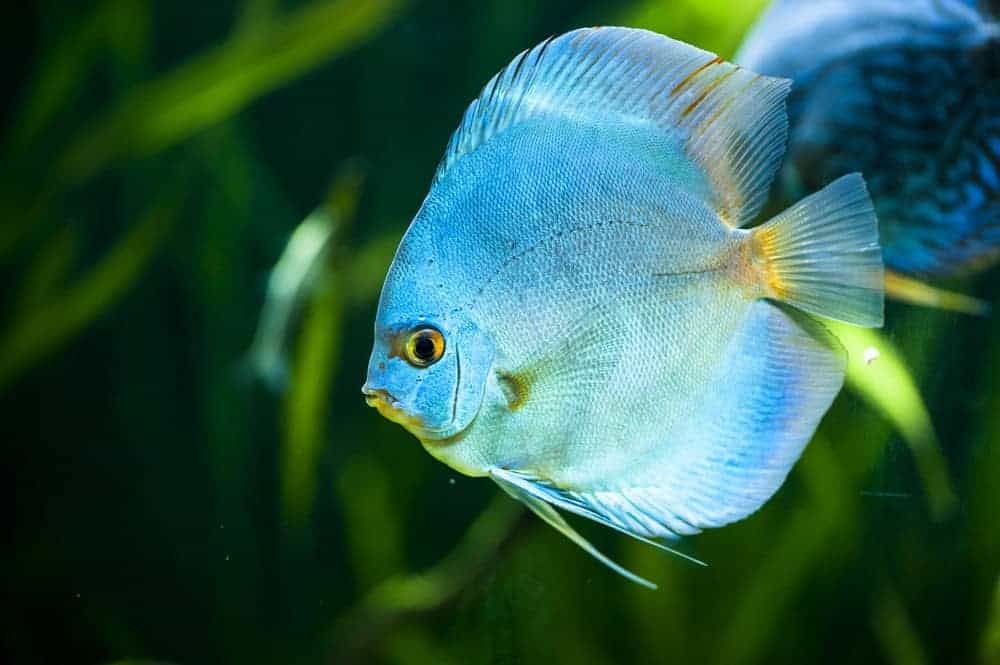
Discus Acclimatization
One of the challenges usually faced when keeping discus fish is getting them acclimated in a new tank. Adult fish may find it easy to adjust to a new location but can also become stressed. They can get ill with the white spot disease, which can be stimulated by relocation. To help their acclimatization, it is vital to prepare a large tank and filter, special food, care, and patience.
Ensure to carry out a chemical test on the tank you want to use to make sure that everything is suitable for the fish. You can add a deworming medication before placing them in the tank or aquarium to guarantee a healthy and parasite-free tank or aquarium. With the tank and water at the right conditions, it would not be many hassles for discus fish to acclimatize.
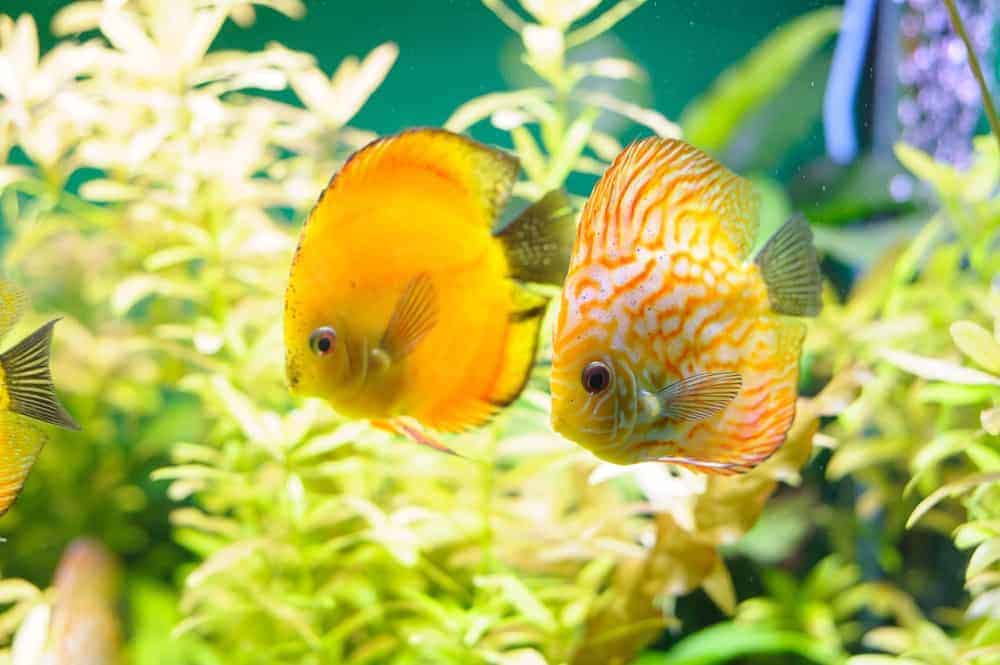
Discus Fish Tank Setup
Getting the right fish tank for discus is not negotiable if you want to keep discus fish. You should get ready a tank of at least 200 liters capacity or larger if you will be keeping more than one fish. The fish require a long and high tank because they are usually tall fish.
The two types of tank suitable for discus, are planted tanks and bare bottom tanks. Planted tanks injected with CO2 will have a lower pH of around 6.8 that is suitable for Discus. It will make Discus feel at home especially of along stem plants and lower foreground plants. Bare bottom tanks do not have any substrate, and that makes the tanks easy to clean from debris and feces. However, a strong and efficient external filter must be provided, and you would need to change the water partially every week.
It is crucial that the tank water is soft and be acidic a little. Also, the comfortable temperature for the fish is 28-32°C (82.4-89.6°F) while the pH should be 6.0-6.5, 10 – 15 dGH. However, discus will fall ill and may die in other tanks apart from two types mentioned.
Discus Feeding
You can feed discus with a wide variety of food. However, they are carnivores and will do well with bloodworms, beef heart, flakes, and pellets because they need vitamins and minerals. Note that discus
Frozen live foods are great for discus but beware of live blackworms because they often carry parasites that can make your discus fall ill.
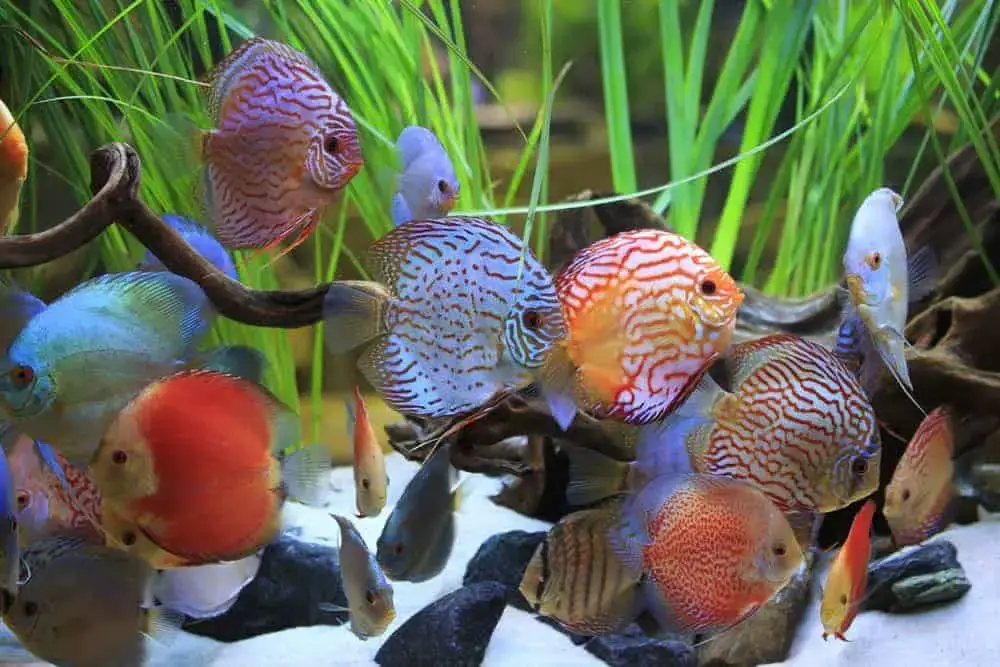
Discus Fish behavior
In their unique nature, discus fish do not like loud sounds or sudden movements that is why they should not be housed with a restless variety of fish. They also do not like sudden movements or knocking on the tank or aquarium. As a result, it is best to place a tank where it will not be subject to frequent disturbances.
How To Breed Discus Fish
Simple Keeping Rules
If you want to experience best discus fish care, follow these rules:
a. Keep them in groups
b. Give them chemical-free water
c. Follow a minimum of 25% weekly water changes
d. Install a biological filter
e. Keep consistent advised levels of pH and hardness
f. Feed discus well; they love to eat
g. Do not dip your hands into the tanks.
Conclusion
Discus fish are one of the most beautiful fish ever discovered. They are beautiful specimen and are worth being displayed for people to appreciate its beauty; little wonder, they are fondly called the “King of the Aquarium.”
Enjoy keeping your discus fish!

Hi, my name is Sean, and I’m the primary writer on the site. I’m blogging mostly about freshwater and saltwater aquariums, fish, invertebrates, and plants. I’m experienced in the fishkeeping hobby for many years. Over the years I have kept many tanks, and have recently begun getting more serious in wanting to become a professional aquarist. All my knowledge comes from experience and reading forums and a lot of informative sites. In pursuit of becoming a professional, I also want to inspire as many people as I can to pick up this hobby and keep the public interest growing.
Read more about Sean.
Please join also my Facebook group.

